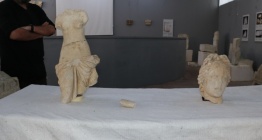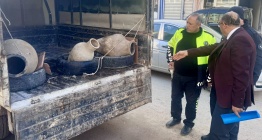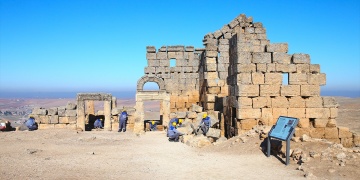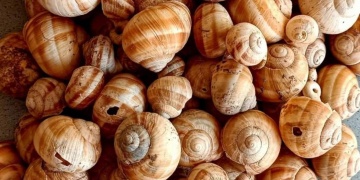Three important presentations on the excavations were made at the 2023 Arab Studies Seminar in Denmark. The aim of the seminar was to introduce the latest academic research in the Arabian Peninsula covering a wide range of subjects such as archeology, history, epigraphy, languages, literature, art, ethnography and geography.
The Department of Culture and Tourism – Abu Dhabi (DCT Abu Dhabi) presented three papers on its latest archaeological findings in the emirate during the 2023 Seminar for Arabian Studies, held this year in Aarhus, Denmark from 4th to 6th August.
DCT Abu Dhabi presented the results of recent work undertaken at Sas al Nakhl Island (formerly known as Umm an-Nar Island), famed for its Bronze Age tombs and settlements that were first excavated by a Danish archaeology team in 1959. Since then, several further excavations have been conducted, and new data presented at the seminar will help paint a chronological picture of the island’s local economy, long-distance exchange, and everyday life in past eras.
The second paper revealed the discovery of neolithic stone-lined pits and hearths found within a large mound on the north coast of Ghagha Island. The latest season of excavation on GHG0063 uncovered possible flues associated with these pits. The flue technology would have been used to regulate and control firing temperatures in the kilns. Radiocarbon dates place the structures at around 6,300 BC, which dates the site to 200 years later than GHG0014, the earliest settlement site found previously on Ghagha. Archaeologists of DCT presented the various structures, stone tools, and plaster vessels recovered from the site. The publication will further discuss whether the nature of the site is more ceremonial, industrial or domestic.
The third paper focused on DCT Abu Dhabi’s discoveries of aflāj (underground water channels) across more than 150 locations in Al Ain. About 60 separate ancient aflāj have been found in three main areas of the city – around Hili Oasis in the north, to the east of Qattara and Jimi Oases, and in the Central District of the downtown area to the east of Al Ain Oasis. The presentation gave a brief introduction to the context of the aflāj discoveries and to the archaeological methodologies employed to investigate and record them.
DCT Abu Dhabi also presented a poster detailing the metal artefacts recovered from Al Ain’s Iron Age site Hili 14. The large conical slag dating back to the Iron Age II Period (c. 1000 BCE – 600 BCE) is located within the boundaries of the Hili Archaeological Park, and potentially documents the various stages involved in the production and refining of metal and artefacts during that period. Since 2011, the Bronze and Iron Age sites of Hili have been listed as one of the components of The Cultural Sites of Al Ain, a UNESCO World Heritage property.
As part of DCT Abu Dhabi’s ongoing efforts to further knowledge of the UAE’s history and safeguard its cultural heritage, excavation and research activities are taking place continuously across Abu Dhabi. DCT Abu Dhabi also partners with leading educational institutes and governmental organisations to provide students, partners, and stakeholders with the most up-to-date knowledge on the management and protection of the historic environment.
The proceedings of the Seminar for Arabian Studies will be published on www.archaeopress.com. The event this year is co-hosted by Moesgaard Museum and Aarhus University.
Sourche: Amjad Saleh - Emirates News Agency







 Bir Sapiens kafilesi Avrupa'ya buz çağında ulaştı, soğuğa direndi ama soyunu sürdüremedi
Bir Sapiens kafilesi Avrupa'ya buz çağında ulaştı, soğuğa direndi ama soyunu sürdüremedi  Prof. Dr. Aytaç Coşkun: Zerzevan Kalesi'nin altında bir yeraltı kenti var
Prof. Dr. Aytaç Coşkun: Zerzevan Kalesi'nin altında bir yeraltı kenti var  Arkeologlar 4 Bin yıl önce salyangozların ne amaçla toplandığını çözmeye çalışıyor
Arkeologlar 4 Bin yıl önce salyangozların ne amaçla toplandığını çözmeye çalışıyor  Binbeşyüz yıl önce Balıkesir'de batan tabak yüklü geminin batığı bulundu
Binbeşyüz yıl önce Balıkesir'de batan tabak yüklü geminin batığı bulundu 




